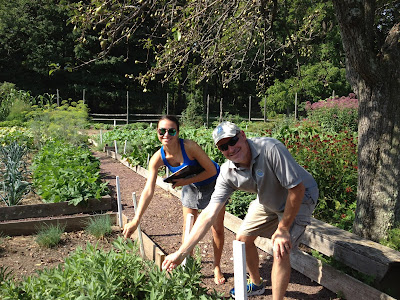 For the last two weeks, I conducted two sets of two day teacher
immersion workshops at Morristown National Historic Park (MNHP) and the Jacobus
Vanderveer House (JVH). My biggest take-away so far from these sessions with
teachers is that there is no limit to the use of our national parks and
historic locations for our schools and students. The teachers on these
workshops developed lesson summaries on topics as diverse as the Civilian
Conservation Corps (CCC) work at MNHP during the Great Depression, the nutritional
and herbal uses of the colonial era garden to enhance food and life and lesson
ideas probing the perspectives of Loyalists, Patriots, children, slaves, Native
Americans and women during the Revolutionary War time period. Other
teachers used the historic, cultural and recreational resources at MNHP and the
JVH to create lessons on invasive plant species, tree canopy coverage and
kindergarten level lessons on place over time and wants and needs as they
related to the children of the Vanderveer and Ford families. My
personal favorite part of these workshops was leading teachers on the process
of “sit-spotting” in nature. This practice was done by Native American groups
as a form of meditation and nature observation. We connected sit-spotting to
everything our ancestors and elders learned about their world. For example, at
MNHP and the JVH, nature awareness and observation utilized by inhabitants of
these areas at different times led to very simple yet powerful outcomes. Their
survival depended upon being nature-aware. Observation gave our ancestors the
knowledge of the best direction to build the front of one’s home (south facing
to gain the most Sun), the simple concept of selecting the best geographic
areas for winter encampments, what herbs to use for medicinal purposes, the
usage of plants to make linens, the best woods to use to make fires, build
cabins and craft boats and so much more. More importantly, sit-spotting allows
teachers and students the time and space to imagine what it was like to be that historic
figure on that property during a specific
moment in time. For me, that simple concept of
experiential, nature and place-based education is probably the most powerful
teaching tool we as educators still have in our bag of tools.
For the last two weeks, I conducted two sets of two day teacher
immersion workshops at Morristown National Historic Park (MNHP) and the Jacobus
Vanderveer House (JVH). My biggest take-away so far from these sessions with
teachers is that there is no limit to the use of our national parks and
historic locations for our schools and students. The teachers on these
workshops developed lesson summaries on topics as diverse as the Civilian
Conservation Corps (CCC) work at MNHP during the Great Depression, the nutritional
and herbal uses of the colonial era garden to enhance food and life and lesson
ideas probing the perspectives of Loyalists, Patriots, children, slaves, Native
Americans and women during the Revolutionary War time period. Other
teachers used the historic, cultural and recreational resources at MNHP and the
JVH to create lessons on invasive plant species, tree canopy coverage and
kindergarten level lessons on place over time and wants and needs as they
related to the children of the Vanderveer and Ford families. My
personal favorite part of these workshops was leading teachers on the process
of “sit-spotting” in nature. This practice was done by Native American groups
as a form of meditation and nature observation. We connected sit-spotting to
everything our ancestors and elders learned about their world. For example, at
MNHP and the JVH, nature awareness and observation utilized by inhabitants of
these areas at different times led to very simple yet powerful outcomes. Their
survival depended upon being nature-aware. Observation gave our ancestors the
knowledge of the best direction to build the front of one’s home (south facing
to gain the most Sun), the simple concept of selecting the best geographic
areas for winter encampments, what herbs to use for medicinal purposes, the
usage of plants to make linens, the best woods to use to make fires, build
cabins and craft boats and so much more. More importantly, sit-spotting allows
teachers and students the time and space to imagine what it was like to be that historic
figure on that property during a specific
moment in time. For me, that simple concept of
experiential, nature and place-based education is probably the most powerful
teaching tool we as educators still have in our bag of tools.--Chris Bickel







No comments:
Post a Comment